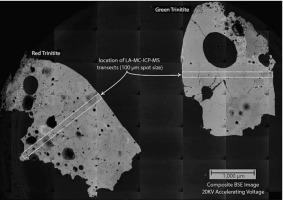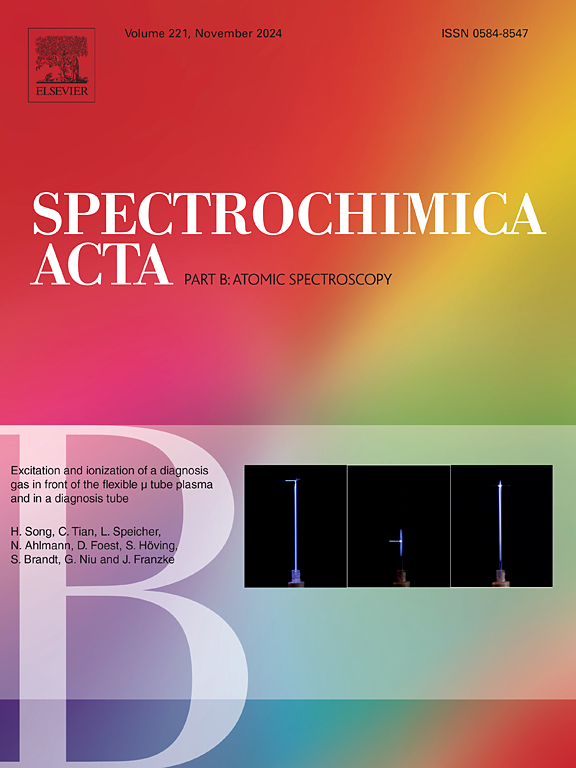在Neoma MC-ICP-MS上激光烧蚀取样测量三位一体石的U-Pu和Ba-Cs同位素
IF 3.8
2区 化学
Q1 SPECTROSCOPY
引用次数: 0
摘要
在这项研究中,我们介绍了通过激光烧蚀(LA)取样获得的U-Pu和Ba-Cs同位素组合测量结果,这些测量结果来自1945年7月16日在新墨西哥州进行的世界上第一颗原子弹爆炸的两块玻璃碎片(“三位一体”)。我们进行这些测量的主要目的是了解通过直接取样(例如,在同位素比率测量之前没有任何化学分离或纯化)检查U-Pu和Ba-Cs系统是否可以产生有意义的信息,以区分三合质碎片和缺乏核裂变特征的玻璃状物质。这些测量是在ThermoFisher Scientific Neoma多收集器-电感耦合等离子体质谱仪(MC-ICP-MS)上进行的,这是一个相对较新的MC-ICP-MS平台,因此我们还研究了这些同位素系统在溶液中取样和通过LA取样的标准中的行为。不出所料,在U、Pu和Ba同位素标准的纯化溶液上进行的测量产生了高精度的同位素比率。这延伸到通过LA采样进行的U-Pu测量,由于矩阵效应和信号强度波动,预期精度和准确性会下降。然而,LA获得的Ba-Cs数据在所有检测的基质中精度较低,并且有证据表明存在复杂的质量分馏,这需要进一步的研究来解决。总之,我们的研究结果表明,观察到的U-Pu同位素数据具有足够的质量,可以准确地约束含有这些元素亚ppm水平的玻璃的U和Pu同位素组成,从而可以用于区分含有人为裂变产物的玻璃和天然玻璃,而Ba-Cs LA数据不能用于此目的,直到进一步的方法改进进行。本文章由计算机程序翻译,如有差异,请以英文原文为准。

U-Pu and Ba-Cs isotopic measurements on Trinitite by laser ablation sampling on the Neoma MC-ICP-MS
In this study we present the results of combined U-Pu and Ba-Cs isotope measurements obtained by laser ablation (LA) sampling of two glassy debris fragments (‘Trinitite’) from the world's first atomic bomb detonation conducted in New Mexico on July 16, 1945. Our primary goal in conducting these measurements was to understand whether examination of the U-Pu and Ba-Cs systematics by direct sampling (e.g. without any chemical separation or purification prior to isotope ratio measurement) could yield meaningful information that would differentiate the Trinitite fragments from glassy material lacking a nuclear fission signature. These measurements were conducted on a ThermoFisher Scientific Neoma multi collector – inductively coupled plasma – mass spectrometer (MC-ICP-MS), which is a relatively new MC-ICP-MS platform, so we also examine the behavior of these isotope systems in standards sampled in solution and via LA. Unsurprisingly, the measurements made on purified solutions of the U, Pu, and Ba isotopic standards produce high precision isotope ratios. This extends to the U-Pu measurements made by LA sampling, with the expected degradation in precision and accuracy related to matrix effects and signal intensity fluctuation. However, the Ba-Cs data acquired by LA is of low precision across all of the matrices examined and bears evidence of complex mass fractionation that will require further investigation to resolve. In total, our results indicate that the observed U-Pu isotope data are of sufficient quality to accurately constrain the U and Pu isotopic composition of glass containing sub-ppm levels of these elements which in turn could be used to differentiate glass containing anthropogenic fission products from natural glass whereas the Ba-Cs LA data cannot be used for this purpose until further methodological refinement is performed.
求助全文
通过发布文献求助,成功后即可免费获取论文全文。
去求助
来源期刊
CiteScore
6.10
自引率
12.10%
发文量
173
审稿时长
81 days
期刊介绍:
Spectrochimica Acta Part B: Atomic Spectroscopy, is intended for the rapid publication of both original work and reviews in the following fields:
Atomic Emission (AES), Atomic Absorption (AAS) and Atomic Fluorescence (AFS) spectroscopy;
Mass Spectrometry (MS) for inorganic analysis covering Spark Source (SS-MS), Inductively Coupled Plasma (ICP-MS), Glow Discharge (GD-MS), and Secondary Ion Mass Spectrometry (SIMS).
Laser induced atomic spectroscopy for inorganic analysis, including non-linear optical laser spectroscopy, covering Laser Enhanced Ionization (LEI), Laser Induced Fluorescence (LIF), Resonance Ionization Spectroscopy (RIS) and Resonance Ionization Mass Spectrometry (RIMS); Laser Induced Breakdown Spectroscopy (LIBS); Cavity Ringdown Spectroscopy (CRDS), Laser Ablation Inductively Coupled Plasma Atomic Emission Spectroscopy (LA-ICP-AES) and Laser Ablation Inductively Coupled Plasma Mass Spectrometry (LA-ICP-MS).
X-ray spectrometry, X-ray Optics and Microanalysis, including X-ray fluorescence spectrometry (XRF) and related techniques, in particular Total-reflection X-ray Fluorescence Spectrometry (TXRF), and Synchrotron Radiation-excited Total reflection XRF (SR-TXRF).
Manuscripts dealing with (i) fundamentals, (ii) methodology development, (iii)instrumentation, and (iv) applications, can be submitted for publication.

 求助内容:
求助内容: 应助结果提醒方式:
应助结果提醒方式:


